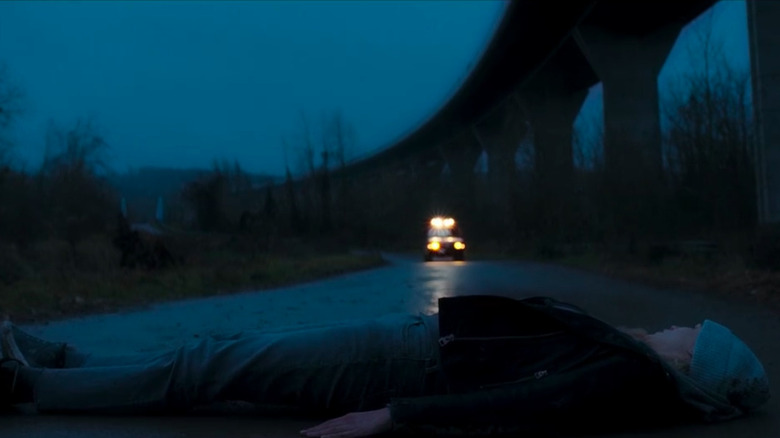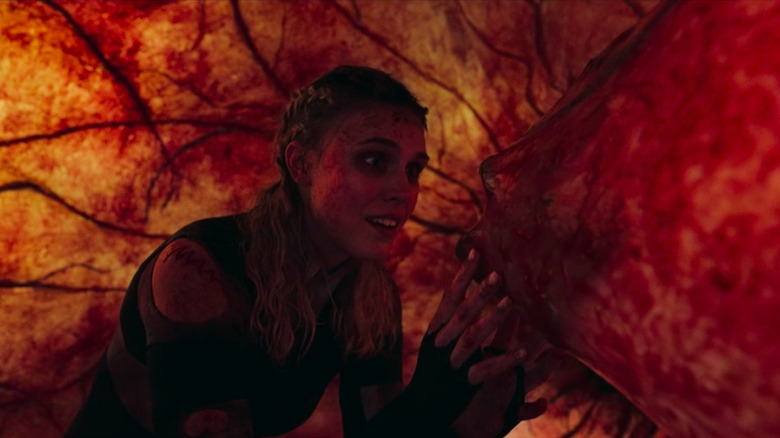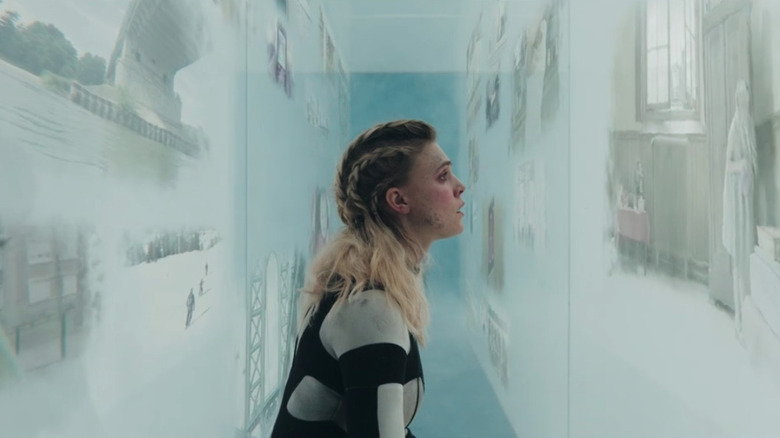The Ending Of Meander Explained
From a claustrophobic thriller to a science-fiction fantasy, "Meander" blurs the genres during its slick 90-minute runtime. The 2020 French film follows a young woman mourning the death of her daughter when she's suddenly thrust into a deadly game of cat and mouse with outside forces.
After being picked up by Adam (Peter Franzén), Lisa (Gaia Weiss) is knocked unconscious. She wakes up in an underground labyrinth of metal tubes with only a glowing bracelet to guide her. When she finally reaches what appears to be a window leading to the outside world, her body is battered but her spirits are high. To her horror, the opening is just a video of the sky.
As she lies there in disbelief, repeating, "I had no chance, but I made it to the end... I did it," something strange happens. Bright light washes over her, and she begins to levitate.
When Lisa wakes up again, she's outside by a waterfall and her daughter Nina (Romane Libert) is there with her. "Did I die?" she asks. The little girl informs her that she died many times, but now all that's left to do is "live."
Director Mathieu Turi told Cineuropa that he wanted the film to be mysterious, though he has explanations for the more ambiguous aspects of the film. "There are clues in the movie, some of them so well hidden that I think no one will ever find them," he said.
So, let's dive into the ending of "Meander."
Does Lisa live happily ever after?
After pushing her way through shifting walls, climbing over dead bodies, avoiding flamethrowers, fighting a zombie, nearly drowning, burning herself in an acid pit, encountering her dead daughter, and having half of her foot chopped off, does Lisa get to have a happy ending?
It's hard to say. After being pulled into a white light and waking up in a luscious natural setting where her wounds have healed, the sun is shining, and the birds are chirping, everything seems okay. She's reunited with her daughter, and there are no immediate threats. However, it's established early on that Nina is dead, so we know that they're in an afterlife where Lisa is also dead.
"Your body (died). Many times," Nina explains to her mother. "But there's nothing left to fear, now. You're safe here."
Lisa asks, "What do I have to do?" and Nina replies, "Live." They exchange relieved smiles and look on at the breathtaking waterfall. They both seem happy, and it can be assumed that they will live in this paradise for eternity.
Given the horrors that Lisa endured in the film, accepting her idealistic fate requires moving past the intricate tortuous tunnels, fleshy chambers, and the role of Adam, a serial killer moving through the maze with her.
What's the deal with Adam?
Before they're locked in the winding tubes, Lisa and Adam met when he happened upon her lying in the street. It's cold, rainy, and getting darker by the minute, so he offers her a ride into town. They make odd small talk about having bad childhoods, disliking people, and she reveals that day would've been her daughter's ninth birthday.
Adam tells her that there's no afterlife, and she turns on the radio, where a broadcaster describes a murder suspect. What are the odds that another man with a cross tattoo on his hand driving a brown truck was in the area? Before she has time to react, Adam slams on the brakes and then attacks her.
Later, it's revealed that Adam was also in the tubes with Lisa. She realizes this after fighting an angry, hysterical man in a tunnel on the verge of filling with flames. He seems to have been down there longer, having a scruffy appearance and a more jaded outlook on their predicament. Whether or not he killed her during the attack, and whether or not they're in a literal purgatory is up for debate, but they both seem to be awaiting their judgment day in this place.
After being scorched to death, Adam returns as the fleshy monster that chases her through the tunnels. Even after death, he is still trapped in this hellish system — perhaps to atone for his heinous crimes. Whereas Lisa moves onto a heaven-like afterlife with her daughter, he will suffer forever.
The cosmic dread of Meander
While promoting his debut film "Hostile," director Mathieu Turi told Screen Anarchy that his then-upcoming film "Meander" was inspired by similar films like "Cube" and "Saw." However, he added that it was more Lovecraftian, "so it goes much deeper and gets really weird."
Literary giant H.P. Lovecraft left behind a complicated legacy, but he influenced an entire subgenre at the intersection of horror and fantasy known as "Weird fiction." An in-depth analysis by Vox explained some of the genre's tropes include "existential wonder," "brief brushes with terrifying otherworldly phenomena," and providing "just enough description to make you feel, along with the characters, as though you've glimpsed the edge of a vast and overwhelming universe full of darkness and terror."
All of these trappings can be found in "Meander," from the veiny, womb-like room where Lisa briefly connects with an unseen being to the Cenobite-like mechanical skull that stitches her gaping wounds. This sense of cosmic dread is lurking throughout the film but is just out of view enough to avoid being exposed.
The Vox article also points out that Lovecraftian content sees characters "confronting the idea of a cold, different, and perhaps even actively hostile cosmic universe." Neither Lisa nor Adam directly address whatever force has placed them here, but Adam warns her of an ominous "them" and it's clear that someone or something beyond their comprehension is in control.
Was it all in Lisa's head?
At the beginning of the film, Lisa is lying in the middle of the road at dusk. She's alone in the outskirts of town on a day that is difficult for her. It's not too far of a reach to wonder if she was trying to end her life but was interrupted by Adam. "I don't want to die," she tells him. "I just want to see my daughter again."
A later flashback reveals that Adam had stabbed Lisa and then thrown her out of the car, where she may have died. The film's events could've been her way of coping with the trauma of the attack and her already unstable mental state during her final moments. In the Cineuropa interview, Turi explains that Lisa following the guiding light of the bracelet could be interpreted as the "light" people see while they're dying.
This "light" directly brings her toward danger, but it also leads her to the aforementioned womb-like chamber that contrasts with the cold metal tubes, and the frosty white room where she watches a lifetime of memories play out. It also allows her to make amends with Nina, who initially begs her to stay in the tubes forever but understands why she must keep going. "I'm proud of you, Lisa," the child says as though her mother had passed a test. "We all are."
"Meander" can be interpreted as an open-ended exploration of grief in which a mother is ready to give up but becomes increasingly empowered to fight for her life against all odds.




